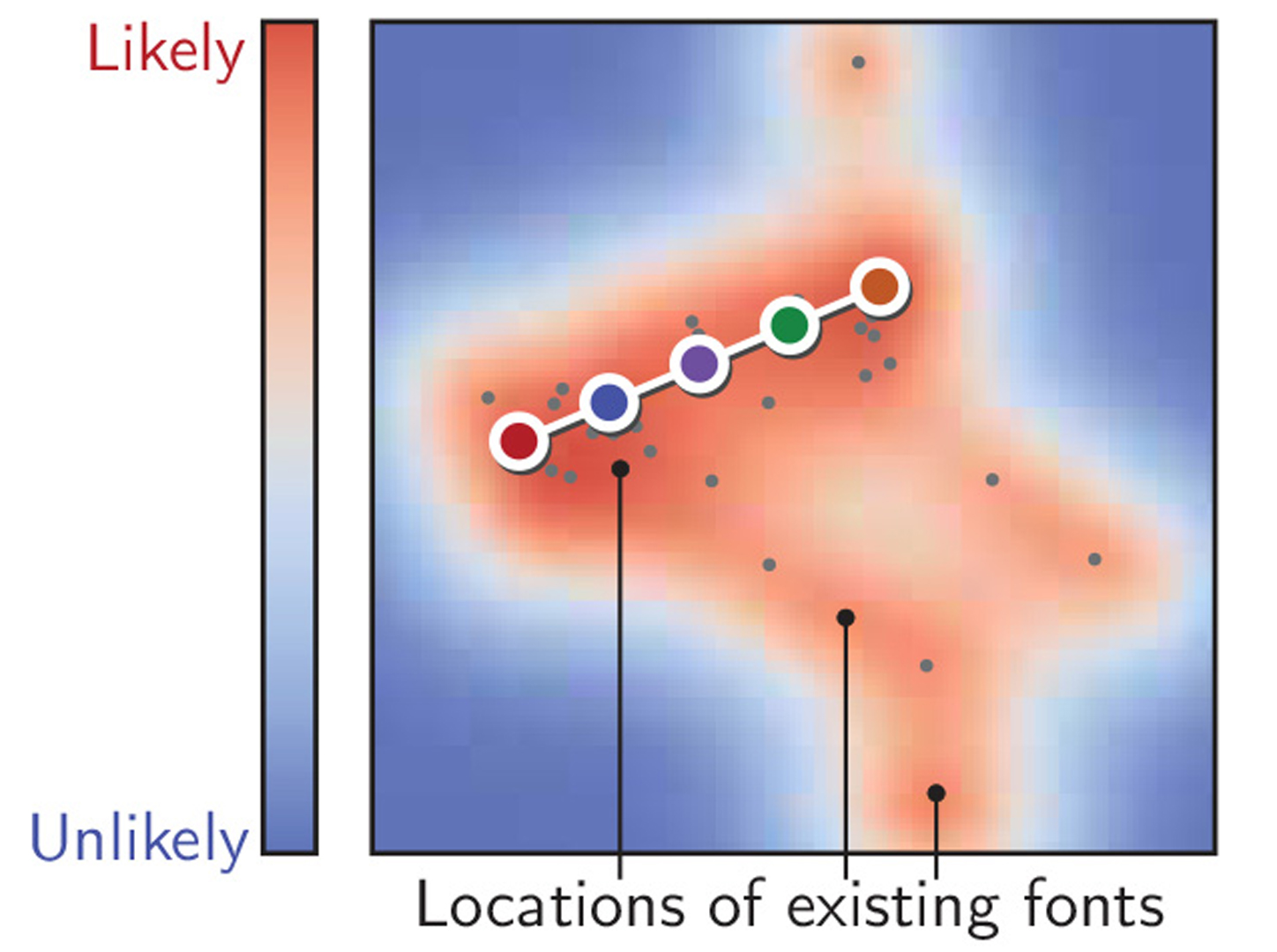“Learning a manifold of fonts” by Campbell and Kautz
Conference:
Type(s):
Title:
- Learning a manifold of fonts
Session/Category Title: Typography & Illustration
Presenter(s)/Author(s):
Moderator(s):
Abstract:
The design and manipulation of typefaces and fonts is an area requiring substantial expertise; it can take many years of study to become a proficient typographer. At the same time, the use of typefaces is ubiquitous; there are many users who, while not experts, would like to be more involved in tweaking or changing existing fonts without suffering the learning curve of professional typography packages.Given the wealth of fonts that are available today, we would like to exploit the expertise used to produce these fonts, and to enable everyday users to create, explore, and edit fonts. To this end, we build a generative manifold of standard fonts. Every location on the manifold corresponds to a unique and novel typeface, and is obtained by learning a non-linear mapping that intelligently interpolates and extrapolates existing fonts. Using the manifold, we can smoothly interpolate and move between existing fonts. We can also use the manifold as a constraint that makes a variety of new applications possible. For instance, when editing a single character, we can update all the other glyphs in a font simultaneously to keep them compatible with our changes.
References:
1. Adobe Systems. 1997. Designing multiple master typefaces. Technical Note #5087.Google Scholar
2. Alexa, M., Cohen-Or, D., and Levin, D. 2000. As-rigid-as-possible shape interpolation. In Proc. of SIGGRAPH ’00, 157–164. Google ScholarDigital Library
3. Barrow, H., Tenenbaum, J., Bolles, R., and Wolf, H. 1977. Parametric correspondence and chamfer matching: Two new techniques for image matching. In Proc. of the International Joint Conference of Artificial Intelligence, 659–663. Google ScholarDigital Library
4. Bonneel, N., van de Panne, M., Paris, S., and Heidrich, W. 2011. Displacement interpolation using lagrangian mass transport. ACM Trans. Graphics 30, 6, 158:1–158:12. Google ScholarDigital Library
5. Hassan, T., Hu, C., and Hersch, R. D. 2010. Next generation typeface representations: Revisiting parametric fonts. In Proc. 10th ACM Symposium on Document Engineering, 181–184. Google ScholarDigital Library
6. Hersch, R. D., and Betrisey, C. 1991. Model-based matching and hinting of fonts. Proc. of SIGGRAPH ’91, 71–80. Google ScholarDigital Library
7. Hu, C., and Hersch, R. D. 2001. Parameterizable fonts based on shape components. IEEE Comput. Graphics Appl. 21, 3, 70–85. Google ScholarDigital Library
8. Itoh, K., and Ohno, Y. 1993. A curve fitting algorithm for character fonts. Electronic Publishing 6, 3, 195–205.Google Scholar
9. Kalogerakis, E., Chaudhuri, S., Koller, D., and Koltun, V. 2012. A probabilistic model for component-based shape synthesis. ACM Trans. Graphics 31, 4, 55:1–55:11. Google ScholarDigital Library
10. Kazhdan, M., Funkhouser, T., and Rusinkiewicz, S. 2004. Shape matching and anisotropy. ACM Trans. Graphics 23, 3, 623–629. Google ScholarDigital Library
11. Kim, V. G., Li, W., Mitra, N. J., Chaudhuri, S., DiVerdi, S., and Funkhouser, T. 2013. Learning part-based templates from large collections of 3d shapes. ACM Trans. Graphics 32, 4, 70:1–70:12. Google ScholarDigital Library
12. Knuth, D. E. 1986. The Metafont Book. Addison-Wesley. Google ScholarDigital Library
13. Kuhl, F., and Giardina, C. 1982. Elliptic fourier features of a closed contour. Computer Graphics and Image Proc. 18, 3, 236–258.Google ScholarCross Ref
14. Lau, V. M. K. 2009. Learning by example for parametric font design. In SIGGRAPH ASIA ’09 Posters, 5:1–5:1. Google ScholarDigital Library
15. Lawrence, N. 2005. Probabilistic non-linear principal component analysis with gaussian process latent variable models. The Journal of Machine Learning Research 6, 1783–1816. Google ScholarDigital Library
16. Loviscach, J. 2010. The universe of fonts, charted by machine. In SIGGRAPH ’10 Talks, 27:1–27:1. Google ScholarDigital Library
17. Navaratnam, R., Fitzgibbon, A., and Cipolla, R. 2007. The joint manifold model for semi-supervised multi-valued regression. In Proc. of IEEE 11th International Conf. on Computer Vision.Google Scholar
18. Prisacariu, V., and Reid, I. 2011. Nonlinear shape manifolds as shape priors in level set segmentation and tracking. In Proc. of IEEE Conf. on Computer Vision and Pattern Recognition. Google ScholarDigital Library
19. Rasmussen, C. E., and Williams, C. 2006. Gaussian Processes for Machine Learning. MIT Press. Google ScholarDigital Library
20. Shamir, A., and Rappoport, A. 1998. Feature-based design of fonts using constraints. In Proc. of Raster Imag. and Dig. Typography ’98. Google ScholarDigital Library
21. Suveeranont, R., and Igarashi, T. 2010. Example-based automatic font generation. In Proc. of 10th Int. Symp. on Smart Graphics. Google ScholarDigital Library
22. Titsias, M., and Lawrence, N. 2010. Bayesian gaussian process latent variable model. In Proc. of 13th Int. Workshop on AI and Stats.Google Scholar
23. van Kaick, O., Zhang, H., Hamarneh, G., and Cohen-Or, D. 2011. A survey on shape correspondence. Computer Graphics Forum 30, 6, 1681–1707.Google ScholarCross Ref
24. Zitnick, C. L. 2013. Handwriting beautification using token means. ACM Trans. Graphics 32, 4, 53:1–53:8. Google ScholarDigital Library
25. Zongker, D. E., Wade, G., and Salesin, D. H. 2000. Example-based hinting of true type fonts. In Proc. of SIGGRAPH ’00, 411–416. Google ScholarDigital Library




